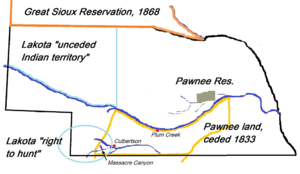Pawnee Reservation facts for kids
The Pawnee Reservation was a special area of land set aside for the Pawnee people in what is now Nebraska. It was located along the Loup River in the central part of the state, in areas that are now Platte and Nance counties. For a long time, the Pawnee people, including groups like the Chaui, Kitkehahki, and Pitahawirata Bands, lived in this region. Their ancestors settled in southeastern Nebraska around the year 900.
Contents
The Pawnee Reservation: A Home for the Pawnee People
Location and Early History
The Pawnee people have a long history in what is now Nebraska. Their ancestors, known as the Kawarakis Pawnees, made their homes in the southeastern part of the state as early as 900 AD. Over many centuries, they lived and thrived on these lands. The specific area that became the Pawnee Reservation was located along the Loup River, a waterway important to their way of life.
How the Reservation Was Formed
The United States government made several agreements, called treaties, with the Pawnee people. These treaties were signed in 1833, 1843, and 1857. Through these agreements, the Pawnee gave up most of their vast lands to the United States. However, they kept a smaller piece of land for themselves. This land became their reservation. It was about 10 miles (16 km) wide and 30 miles (48 km) long, stretching along the Loup River. This was meant to be their permanent home.
What Happened to the Reservation?
After Nebraska became a state, the state government decided to take control of the Pawnee's reservation land. They ended the tribe's rights to their land. The state then sold the land to others. The money from these sales was used to help pay for new lands for the Pawnee people somewhere else.
In the mid-1870s, the remaining parts of the reservation were also sold. By 1876, the Pawnee tribe was moved from Nebraska to a new location. They were relocated to what is now central Oklahoma, where many of their descendants live today.
The Genoa Indian Industrial School
Years after the Pawnee people had moved, a school was built on the former reservation lands. This school was called the Genoa Indian Industrial School. It was built in 1884 in the town of Genoa, which is located right where the Pawnee Reservation used to be. This school was part of a larger system of boarding schools for Native American children, which aimed to teach them skills and customs of the wider American society.


